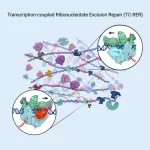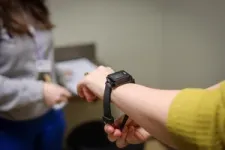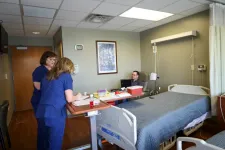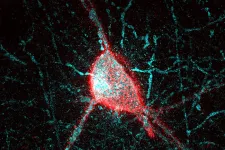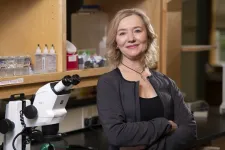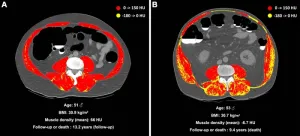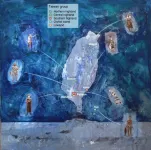(Press-News.org) A new study adds to an emerging, radically new picture of how bacterial cells continually repair faulty sections of their DNA.
Published online May 16 in the journal Cell, the report describes the molecular mechanism behind a DNA repair pathway that counters the mistaken inclusion of a certain type of molecular building block, ribonucleotides, into genetic codes. Such mistakes are frequent in code-copying process in bacteria and other organisms. Given that ribonucleotide misincorporation can result in detrimental DNA code changes (mutations) and DNA breaks, all organisms have evolved to have a DNA repair pathway called ribonucleotide excision repair (RER) that quickly fixes such errors.
Last year a team led by Evgeny Nudler, PhD, the Julie Wilson Anderson Professor in the Department of Biochemistry and Molecular Pharmacology at NYU Langone Health, published two analyses of DNA repair in living E. coli cells. They found that most of the repair of certain types of DNA damage (bulky lesions), such as those caused by UV irradiation, can occur because damaged code sections have first been identified by a protein machine called RNA polymerase. RNA polymerase motors down the DNA chain, reading the code of DNA “letters” as it transcribes instructions into RNA molecules, which then direct protein building.
Nudler and coworkers found that during this transcription process, RNA polymerase also finds DNA lesions, and then serves as a platform for the assembly of a DNA repair machine called nucleotide excision repair (NER) complex. NER then snips out faulty DNA found and replaces it with an accurate copy. Without the action of RNA polymerase, little NER, if any, occurs in living bacteria.
Now the new study in Cell provides the first evidence that, like in the NER pathway, RER is tightly coupled to transcription. The study authors found evidence that the key enzyme involved in RER, RNaseHII, also cooperates with RNA polymerase as it scans for misincorporated ribonucleotides in the DNA chains of living bacterial cells.
“Our results continue to inspire a rethinking of certain basic principles in the DNA repair field,” says Nudler, also an investigator with the Howard Hughes Medical Institute. “Moving forward, our team plans to investigate whether RNA polymerase scans DNA for all kinds of problems and triggers repair genome-wide, not only in bacteria, but in human cells as well.”
Cutting Edge Techniques
Ribonucleotides (the building blocks of RNA) and deoxyribonucleotides (DNA components) are related compounds. As cells copy and build DNA chains in bacterial cells, they often mistakenly incorporate ribonucleotides into DNA chains in place of deoxyribonucleotides because they differ by only a single oxygen atom, say the study authors. In bacterial cells, DNA polymerase III is known to make about 2,000 of these mistakes every time it copies a cell’s genetic material. To maintain genome integrity, the bulk of misplaced ribonucleotides are removed by the RER pathway, but a key question had been about how RNaseHII finds relatively rare ribonucleotide lesions amidst an “ocean” of intact cellular DNA codes so quickly.
As they did in their 2022 studies, the researchers used quantitative mass spectrometry and in vivo protein-protein crosslinking to map the distances between chemically linked proteins, and so determined the key surfaces of RNaseHII and RNA polymerase as they interact in living bacterial cells. In this way they determined that most RNaseHII molecules couple with RNA polymerase.
In addition, they used cryogenic electron microscopy (CryoEM) to capture the high-resolution structures of RNaseHII bound to RNA polymerase to reveal the protein-protein interactions that define the RER complex. Further, structure-guided genetic experiments that weakened the RNA polymerase/RNaseHII interaction compromised RER.
“This work supports a model where RNaseHII scans DNA for misplaced ribonucleotides by riding on RNA polymerase while it moves along DNA,” says first study author Zhitai Hao, a post-doctoral scholar in Nudler’s lab. “This work is vital for our basic understanding of the DNA repair process and has far-reaching clinical implications.”
Along with Nudler and Hao, study authors in the Department of Biochemistry and Molecular Pharmacology the NYU Grossman School of University School of Medicine were Manjunath Gowder, Binod Bharati, Vitaly Epshtein, Vladimir Svetlov, and Ilya Shamovsky. The study was supported by the National Institute of Health, the Howard Hughes Medical Institute, and by the Blavatnik Family Foundation.
END
Researchers reveal DNA repair mechanism
2023-05-16
ELSE PRESS RELEASES FROM THIS DATE:
Three professional societies unite on National Science Foundation grant in effort to increase access and inclusivity in ornithology
2023-05-16
CHICAGO — May 16, 2023 — The landscape of science is changing: People from increasingly varied backgrounds, identities, cultures, and genders are pursuing careers in STEM (science, technology, engineering, and mathematics) fields. Support for this more diverse population of scientists needs to extend beyond “one size fits all” to better meet the needs of today’s scientists. Expanding support and strengthening the sense of community for individuals and groups who have not been historically welcomed in a discipline can foster a deeper sense of belonging and meaningfully broaden representation within that field. Researchers ...
NIH launches largest precision nutrition research effort of its kind
2023-05-16
The National Institutes of Health is now enrolling participants in a landmark initiative to advance nutrition research. Nutrition for Precision Health, powered by the All of Us Research Program, or NPH, is working with 14 sites across the United States – including Pennington Biomedical Research Center and LSU Health Sciences New Orleans in Louisiana – to engage 10,000 participants from diverse backgrounds and learn more about how our bodies respond differently to food.
“Nutrition for Precision Health brings us a step closer to precision medicine. The study will generate a massive ...
Study first to examine how early memory changes as we age at a cellular level
2023-05-16
How do our brains become capable of creating specific memories? In one of the first preclinical studies to examine memory development in youth, a research team at The Hospital for Sick Children (SickKids) may have identified a molecular cause for memory changes in early childhood.
Event-based memories, also known as episodic memories, are what people traditionally think of when they hear the word memory: a recollection tied to a specific context. For young children, however, memory is more general or “gist”-like, and these general recollections are typically not tied to a specific context.
In a study published in ...
New paper introduces ethics framework for use of Generative AI in healthcare
2023-05-16
A new paper published by leading Australian AI ethicist Stefan Harrer PhD proposes for the first time a comprehensive ethical framework for the responsible use, design, and governance of Generative AI applications in healthcare and medicine.
The peer-reviewed study published in The Lancet’s eBioMedicine journal details how Large Language Models (LLMs) have the potential to fundamentally transform information management, education, and communication workflows in healthcare and medicine but equally remain one of the most dangerous and misunderstood types of AI.
“LLMs used to be boring and safe. They have become exciting ...
Accomplished molecular biologist to lead new group at MDI Biological Laboratory
2023-05-16
Halyna Shcherbata, Ph.D., will lead a new research group at MDI Biological Laboratory, in the Kathryn W. Davis Center for Regenerative Biology and Aging. Shcherbata's work has focused on regulatory and other roles of non-coding microRNA in gene expression and maintenance, and disorders such as muscular dystrophy and developmental delay. She is already developing new facilities for Drosophila melanogaster fruit flies on campus, returning an esteemed stand-in for human physiology to the Laboratory’s roster of animal models.
In her new lab on Maine's Mt. Desert ...
Muscle fat linked to higher mortality risk
2023-05-16
OAK BROOK, Ill. – Asymptomatic adults with a high accumulation of fat in their muscles, known as myosteatosis, are at an increased risk of major adverse events and death, according to a study published in Radiology, a journal of the Radiological Society of North America (RSNA).
One of the methods used by physicians to estimate body fat in patients is the body mass index (BMI). Since BMI is calculated using only a patient’s height and weight, it’s not an accurate reflection of body composition ...
ChatGPT passes radiology board exam
2023-05-16
OAK BROOK, Ill. – The latest version of ChatGPT passed a radiology board-style exam, highlighting the potential of large language models but also revealing limitations that hinder reliability, according to two new research studies published in Radiology, a journal of the Radiological Society of North America (RSNA).
ChatGPT is an artificial intelligence (AI) chatbot that uses a deep learning model to recognize patterns and relationships between words in its vast training data to generate human-like responses based on a prompt. But since there is no source of truth in its training data, the tool can generate responses that are factually ...
MD Anderson awarded over $5.7 million from Break Through Cancer to support AML research
2023-05-16
HOUSTON – The University of Texas MD Anderson Cancer Center was awarded more than $5.7 million in grants from Break Through Cancer to support collaborative research teams working to discover novel molecular targets to eradicate minimal residual disease in acute myeloid leukemia (AML) and to treat clonal hematopoiesis, a precursor to AML.
MD Anderson received $2.7 million to fund research for the Targeting Clonal Hematopoiesis to Prevent AML TeamLab and $3 million for the Eradicating Minimal Residual Disease in AML TeamLab. The projects expand upon work initiated within MD Anderson’s Myelodysplastic Syndromes and Acute Myeloid ...
Magnetic stimulation may improve the pain, nausea of diabetic gastroparesis
2023-05-16
AUGUSTA, Ga. (May 16, 2023) – Magnetic stimulation of a group of nerves key to how our gut and brain communicate may help correct the conversation that goes awry in painful, debilitating diabetic gastroparesis, researchers say.
Patients come to Amol Sharma, MD, because their stomachs constantly hurt, they are always nauseous and they can’t or won’t eat or drink. Sometimes they can’t get out of the hospital because of nausea and vomiting.
“Gastroparesis is suspected in about 2% of the population, which is the about the population of Missouri, but only confirmed in .2% ...
Genetic analysis of Indigenous Taiwanese peoples sheds light on Austronesian expansion
2023-05-16
The Austronesian language family is one of the largest in the world, comprising over 1,200 languages spoken from Madagascar to Hawaii. Dang Liu, Albert Min-Shan Ko and Mark Stoneking collected genome-wide data from 55 individuals from seven Taiwanese Austronesian groups and two Han-Taiwanese groups to study the genetic structure of Taiwan, the point of origin for all Austronesian-speaking peoples. There are over 20 different Indigenous groups in Taiwan, divided into “highland” and “lowland” peoples. Many lowland peoples have intermarried with Han people, and their languages are endangered or extinct. ...
